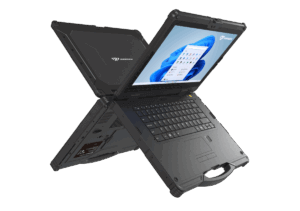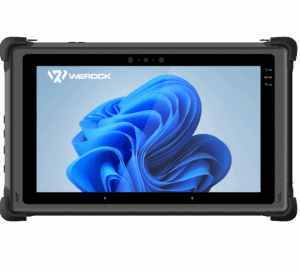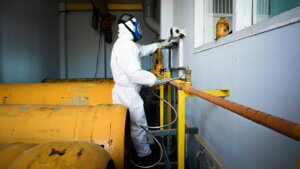Mobile data capture devices and barcodes are indispensable tools for efficiently capturing and analyzing data. But what technologies are behind these devices? And what is important when choosing the right scanner? In this article, we take a look behind the scenes and show you how to optimize your processes with the right technology.
What are mobile data collection devices (MDCs)
Mobile data collection devices (MDCs) are portable computers that are used in companies to collect, record and process data quickly and easily. They are often used in warehouses, production halls and in retail. With the help of barcodes, information such as product numbers, stock levels or delivery data can be recorded and digitally processed directly on site, away from a stationary computer.
They are available in different types and shapes and come as PDAs, handhelds, tablet PCs, forklift terminals and mobile terminals.
Nothing works without barcodes: Barcodes for modern data capture
The main advantages of barcodes are their high scanning speed and efficient information processing, and they also reduce human error when entering data. To achieve optimum scanning results, high print quality, coloring and material must be coordinated. High contour sharpness plays a decisive role in achieving the best results. For excellent print quality, we recommend thermal transfer or direct thermal printing as the preferred printing techniques.
In order to highlight the differences between the two printing techniques, we would like to give you a brief and concise insight. With direct thermal printing, a special thermal paper is printed directly using heat. This process is fast and cost-effective, but is more suitable for short-lived barcodes, as the print quality is limited.
Thermal transfer printing, on the other hand, uses a ribbon to transfer the ink to various materials. This method provides long-lasting, high-quality barcodes, but is more cost-intensive. Choosing the right process depends on factors such as durability, print quality and cost. Thermal transfer printing is ideal for demanding applications where the barcodes are exposed to extreme conditions and high readability must be guaranteed over a long period of time. They are used, for example, for product labels or warehouse identification.
As you can see, when choosing a suitable label printer, you should consider the type of label, its durability, the print resolution and the required quantity of labels.
We offer the right mobile label printer solution for every application with the TSC Alpha series (TSC Alpha-30L, TSC Alpha-40L).
If you would like to delve further into the subject of barcodes, our Barcode Lexicon is the right place to start.
Barcodes in practice
Barcodes are proving to be indispensable in many areas. In warehouse management, they have revolutionized processes by clearly identifying each individual product, device and system. This ensures complete transparency in inventory management.

Barcodes are real time savers when it comes to stocktaking. With a simple scan, all items can be recorded in a matter of seconds. Barcodes also offer the option of storing and retrieving extensive additional information. Additional data such as purchase date or depreciation can be called up immediately. In this process, for example, production data, supplier information or maintenance intervals can be assigned directly to the respective barcode.
In sectors such as the pharmaceutical industry, where maximum precision and security are required, 2D barcodes have become particularly popular. These can store a much larger amount of data than 1D barcodes. Even if a 2D barcode is partially damaged, it can often still be read without any problems. This significantly reduces the susceptibility to errors and ensures the traceability of products.
We are also encountering 2D barcodes more and more frequently in everyday life. Whether in the supermarket, in the library or on shipping boxes. They have become an integral part of our lives.
It all depends on the right tools: Choosing the right barcode scanner
Choosing the right barcode scanner is crucial for your company’s productivity. A good scanner is characterized by speed, precision and robustness. It should also capture barcodes reliably, even when held at a slight angle. It should have internal error correction to read poorly printed or damaged barcodes.
Whether in the warehouse, in retail or in production – the right scanner must be adapted to your individual requirements. Factors such as the type of barcodes to be scanned, the environmental conditions and the desired reading speed play an important role in the selection process.

The right scanner should be adapted to your company infrastructure and it is helpful to analyze the places where barcodes are scanned and which technology is predominant in your company.
You should consider the following criteria when deciding on a suitable scanner. Are mainly laser scanners in use? What scanning range is required? What is the work application and environment like? Do you have handheld, stationary or hands-free scanners?
To give an example: In retail, simple 1D barcodes are often preferred as they are compatible with all common checkout systems. There is usually less scanning volume throughout the day than in a logistics center.
Our range of mobile data collection devices:
The Rockscan A260 is a robust handheld computer for mobile use in logistics, at events in parcel distribution and anywhere else where data needs to be captured on the move. It offers a high-end 1D/2D Aiming LED barcode scanner, seamless connectivity with WLAN, Bluetooth 5 and Dual Sim. It can withstand drops, is fully waterproof and has a large, replaceable battery.
The Rockscan W100 is a wearable barcode scanner and a true all-rounder that can read all 1D and 2D barcode formats, fits into any environment and is flexible in its areas of application. It can be used in retail, transportation and logistics, warehousing and distribution as well as in manufacturing. We also offer a wide range of accessories so that it can be used as a glove scanner, ring scanner or with a trigger strap on the hand. The Rockscan W100 can perform approx. 5000 scans per battery charge.
For lower scanning volumes, take a look at our Rocktab S500 series. They are the ideal tablets and companions for mobile data capture.
Conclusion
Mobile data collection devices (MDC) and barcodes are indispensable for your efficient business processes today. MDCs enable data to be captured quickly and accurately directly at the point of use. Barcodes, on the other hand, serve as unique identifiers for products and facilitate inventory management. The choice of the right scanner depends on factors such as the barcodes to be scanned, the environmental conditions and the desired reading speed.
In addition, the print quality of barcodes is crucial for reliable capture. Thermal transfer printing offers long-lasting, high-quality barcodes, while direct thermal printing is suitable for short-lived applications.
By using MDC and barcodes, you can optimize processes in your company, reduce errors and increase transparency in the supply chain. Whether in warehouse management, production or retail – the right combination of hardware and software increases efficiency and productivity. With the right choice of MDC devices and scanning technologies, you can further strengthen your company’s competitiveness, prepare for the future and save money over a longer period of time.
Contact us today to find out more about our MDC devices and scanning solutions! Together we will develop the optimal solution for your specific requirements and strengthen your competitiveness for the future.











